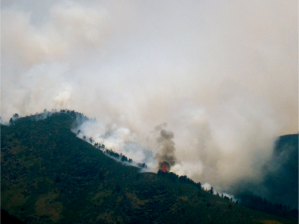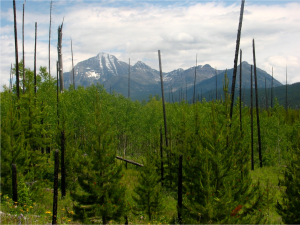
Article: Creative Destruction: Why the same fires that devastate our communities breathe life into our forests. Sarah Bisbing & Kristen Pelz
If we apply available ecological knowledge, can we shift the human-wildfire relationship from a struggle to a form of co-existence?
By Sarah Bisbing & Kristen Pelz
In early June 2012, a lightning strike ignited Colorado’s High Park Fire – to-date the second largest and second most destructive wildfire in state history. In just over three weeks, this formidable force of nature has scorched close to 90,000 acres and destroyed over 250 homes. Although unpredictable, a fire of this scale and magnitude was inevitable given the conditions present across the forested landscapes of Colorado and the Rocky Mountain west. Now, nine wildfires burn across the state of Colorado, scorching 155,000 acres (year-to-date acreage = 173,000 acres) and requiring deployment of over half of our federal firefighting resources.
Our alteration of forests, along with our increasing presence in them, has left many forests functioning outside their natural frequency of fire. For over a century, fire exclusion (or suppression) has been the dominant form of fire management across the mountain west. In many forests across the Front Range of Colorado, areas that historically experienced frequent fire, the removal of this natural process has led to an unnatural buildup of fuels (meaning there is more to burn). So, when these forests do ultimately burn, fires tend to be much larger and much more destructive – bringing about severe consequences for landscapes and communities.
Combine human activities (active wildfire suppression and the growth of communities into forested areas) with natural ecosystem functioning (the fact that species and ecosystems are fire-adapted, and the reality that severe drought and extreme temperatures are becoming more and more common with climatic change), and we are left with a recipe for disaster. Literally.
Without a doubt, the protection of homes and lives must be the highest priority above all else in fire management.  Large wildfires near urban areas often result in loss of property, loss of livelihood, and, in rare instances, even loss of human life.
Large wildfires near urban areas often result in loss of property, loss of livelihood, and, in rare instances, even loss of human life.
Consequently, and rightly, people tend to view wildfire as bad and damaging. But, fire is a natural part of every forest, breathing new life into forests by promoting new growth and regeneration. Creative destruction. If we apply available ecological knowledge, can we shift the human-wildfire relationship from a struggle to a form of co-existence? What can we learn from seeing a forest for what it is? Let’s focus on the species and the ecosystem for a moment.
Forests and Fires Go Hand-in-Hand
Ecologically speaking, nearly every forest has evolved with and is adapted to a specific ‘fire regime’ (the behavior of fire in a particular forest, including things like fire frequency, fire impact, and how hot a fire burns). Fire regimes are location-specific, resulting from a combination of climate and environment[1]. Fires of low severity typically occur much more frequently, while fires of high severity tend to be infrequent. Wildfire frequency and impact have a tremendous effect on three aspects of a forest: the types of trees and other vegetation present (‘composition’), the distribution of trees and other woody plants (‘structure’), and the occurrence of processes like nitrogen cycling and carbon sequestration (‘function’).
These characteristics, in turn, influence fire behavior. Fire spread is governed by the structure and composition of forest vegetation. As a result, a forest that differs significantly from its ‘natural’ structure and composition often drives wildfire to be more severe and much larger than those under which the forest and forest species are adapted – leading to the current situation in Colorado.
The trees across Colorado’s Front Range are all fire-adapted species. Each species has evolved with and is accustomed to a specific combination of fire frequency and severity. Ponderosa pine, for instance, has thick bark that allows it to survive frequent, but low-severity, fires. Fires of low severity burn grass and understory plants but leave forest canopies intact. This fire regime was historically very common across the Front Range (typically every 8-25 years). Ponderosa pine not only survives such fires but also capitalizes on this understory burn, germinating and establishing best after fire wipes the ground clean.

In contrast, high-severity fires were historically more infrequent. These fires reach the forest canopy, consuming tree needles and small branches. Lodgepole pine, another common Front Range tree species, is adapted to these low-frequency, high-severity regimes. This species has evolved under a scenario where fires occur every century or two. A century or two without fire allows a dense forest to grow before fire returns. Lots of trees with even more needles drives rapid spread of fire through the crown, leading to fires more severe than those common in ponderosa pine forest types. But, lodgepole pine needs these big fires. Regeneration of lodgepole pine is dependent upon these large, hot fires. Because lodgepole pine evolved under this type of fire regime, its reproductive strategy takes advantage of these low-frequency, high-severity fires. To contend with high-impact fire, lodgepole pine produce cones that open following exposure to extreme heat (termed ‘serotiny’). This serotinous strategy is one piece of evidence that fire was historically a prevalent disturbance across the lodgepole pine ecosystems of the Rocky Mountains.
Though trees are the big players in forests, understory species (like grasses, shrubs, and forbs) also have a strong evolutionary relationship with fire. Following fire, areas dominated by sprouting species (aspen, cottonwood, gambel oak, many grasses, and many shrubs) tend to rapidly return to pre-fire conditions. On the other hand, where a dense understory is the norm, other vegetative strategies may come into play. For example, some forest plants lay dormant under typical or ‘normal’ forest conditions; lying in wait to germinate or disperse after a fire provides an open canopy and abundant light. Seed banks stored in the soil (snowbrush) or forest canopy (lodgepole pine) provide ample seed for regeneration. These species, many of which were previously rare or absent, flourish under the new conditions.
Dr. Dan Binkley, professor in CSU’s Department of Ecosystem Science and Sustainability, points out, “Before the

Hourglass Fire near Pingree Park, only a few shrubs of snowbrush were present across the landscape. After the fire, tens of thousands of seeds germinated after a century of dormancy in the soil. The proliferation of this formerly rare shrub may enhance soil recovery, as snowbrush is capable of fixing atmospheric nitrogen into forms that plants can use.”
‘Adaptive’ Management
Each species is adapted to a specific fire regime. Working with, rather than against, these relationships will ultimately promote sustainable land management and reduce the negative impacts associated with this natural process. Allowing fire to run its course in a ponderosa pine forest would benefit both people and forests. Although fire would be more frequent, these fires would be much smaller and much less severe. Fires of this size and magnitude would be easier to monitor and could be controlled by local firefighting resources.
Ignoring what we know about species and ecosystems will, however, only exacerbate the human-wildfire conflict. A large portion of Colorado’s forest is burning, providing land managers with a clean slate. We can continue with business as usual, or we can work with species’ adaptations to manage fire. It is up to us what we choose to do with this “new” landscape.
As with most anything in nature, however, no one story can accurately illustrate the impact on and response of a forest to wildfire. Fire is unpredictable, and every forest fire is driven by a complex and unique set of factors. In the case of forests and wildfire, one size does not fit all, but incorporation of the best available science in land management has the potential to promote the most equitable outcome for people and forests.

A large body of ecological knowledge and information exists – information on species adaptations to fire, forest types, fire regime histories, and landscape characteristics, for instance. Sound planning should be based on our acceptance of fire as a natural ecological process, and fire management plans should be informed by the ecological knowledge at hand. Furthermore, the Front Range of Colorado is home to some of the world’s foremost experts in forest ecology, fire science, and fire behavior. It’s time to take advantage of these local resources and integrate ecological knowledge into land management and wildfire planning[2].
As a final note, we must remember that any action taking place on federal lands, be it timber extraction or wildfire mitigation, must have the blessing of its owners: the American public. And, the best decisions made by this body of individuals are those stemming from interest, a sense of ownership, and, above all else, a sound base of information for decision-making. Knowledge truly is power. We must remember that there is nothing that can be done to stop wildfire from occurring. We can, however, use ecological knowledge to mitigate the impact of wildfire on our communities and ecosystems. Just remember: forests are awesome, fires are natural, and our actions influence both. Let’s make sure we take the best actions. Spread the word. (Especially the part about forests being awesome!)
__________________________________________________________________________________
 To learn how you can help those impacted by the recent fires in Colorado, please go to the American Red Cross Colorado Chapter webpage here: http://www.denver-redcross.org/index.asp?IDCapitulo=Q4Q26NY21N
__________________________________________________________________________________
To learn how you can help those impacted by the recent fires in Colorado, please go to the American Red Cross Colorado Chapter webpage here: http://www.denver-redcross.org/index.asp?IDCapitulo=Q4Q26NY21N
__________________________________________________________________________________
Sarah Bisbing is a forest ecologist and PhD candidate in Forest and Rangeland Stewardship at Colorado State University. Sarah’s research addresses the distribution of, genetic variation among, and adaptive potential of Pinus contorta (lodgepole pine in the Rocky Mountains). Feel free to connect with her in the following ways:
- Email her at sarah.bisbing@colostate.edu
- Follow her on Twitter at @SarahBisbing
- Check out her research at warnercnr.colostate.edu/~sbisbing
Kristen Pelz is a forest ecologist and PhD student in Forest and Rangeland Stewardship. Kristen studies subalpine forest disturbance ecology and management. Please feel free to contact her at kristen.pelz@colostate.edu.
** You can also find Sarah and Kristen blogging at http://earlycareerecologists.wordpress.com **[1] Wildfire is shaped by an area’s management history, current and past climatic conditions, species occurrence, topographic variability, fuel loading, and weather present during both ignition and spread. Unique combinations of these variables are what make wildfire so unpredictable.
[2] Collaborative forest restoration groups have started working across the Front Range. These groups integrate managers, scientists, and communities to plan, implement, and monitor forest management. See the Front Range Roundtable (www.frontrangeroundtable.org), the Colorado Forest Restoration Institute (http://warnercnr.colostate.edu/cfri-collaborative-forest-landscape-restoration-program), and the Big Thompson Watershed Forum (http://www.btwatershed.org/about.htm) for more information.